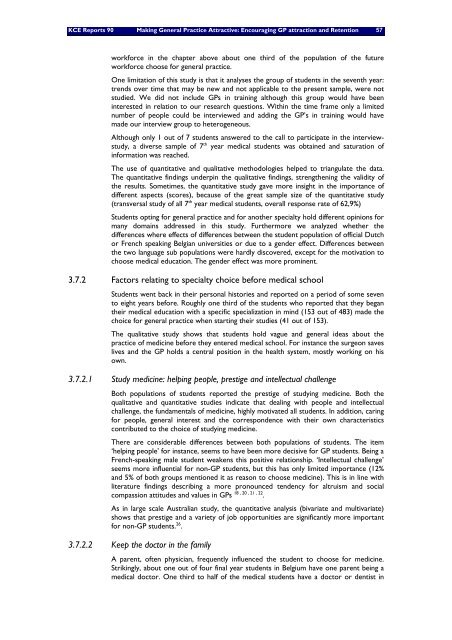Download the report (150 p.) - KCE
Download the report (150 p.) - KCE
Download the report (150 p.) - KCE
Create successful ePaper yourself
Turn your PDF publications into a flip-book with our unique Google optimized e-Paper software.
<strong>KCE</strong> Reports 90 Making General Practice Attractive: Encouraging GP attraction and Retention 57<br />
workforce in <strong>the</strong> chapter above about one third of <strong>the</strong> population of <strong>the</strong> future<br />
workforce choose for general practice.<br />
One limitation of this study is that it analyses <strong>the</strong> group of students in <strong>the</strong> seventh year:<br />
trends over time that may be new and not applicable to <strong>the</strong> present sample, were not<br />
studied. We did not include GPs in training although this group would have been<br />
interested in relation to our research questions. Within <strong>the</strong> time frame only a limited<br />
number of people could be interviewed and adding <strong>the</strong> GP’s in training would have<br />
made our interview group to heterogeneous.<br />
Although only 1 out of 7 students answered to <strong>the</strong> call to participate in <strong>the</strong> interviewstudy,<br />
a diverse sample of 7 th year medical students was obtained and saturation of<br />
information was reached.<br />
The use of quantitative and qualitative methodologies helped to triangulate <strong>the</strong> data.<br />
The quantitative findings underpin <strong>the</strong> qualitative findings, streng<strong>the</strong>ning <strong>the</strong> validity of<br />
<strong>the</strong> results. Sometimes, <strong>the</strong> quantitative study gave more insight in <strong>the</strong> importance of<br />
different aspects (scores), because of <strong>the</strong> great sample size of <strong>the</strong> quantitative study<br />
(transversal study of all 7 th year medical students, overall response rate of 62,9%)<br />
Students opting for general practice and for ano<strong>the</strong>r specialty hold different opinions for<br />
many domains addressed in this study. Fur<strong>the</strong>rmore we analyzed whe<strong>the</strong>r <strong>the</strong><br />
differences where effects of differences between <strong>the</strong> student population of official Dutch<br />
or French speaking Belgian universities or due to a gender effect. Differences between<br />
<strong>the</strong> two language sub populations were hardly discovered, except for <strong>the</strong> motivation to<br />
choose medical education. The gender effect was more prominent.<br />
3.7.2 Factors relating to specialty choice before medical school<br />
Students went back in <strong>the</strong>ir personal histories and <strong>report</strong>ed on a period of some seven<br />
to eight years before. Roughly one third of <strong>the</strong> students who <strong>report</strong>ed that <strong>the</strong>y began<br />
<strong>the</strong>ir medical education with a specific specialization in mind (153 out of 483) made <strong>the</strong><br />
choice for general practice when starting <strong>the</strong>ir studies (41 out of 153).<br />
The qualitative study shows that students hold vague and general ideas about <strong>the</strong><br />
practice of medicine before <strong>the</strong>y entered medical school. For instance <strong>the</strong> surgeon saves<br />
lives and <strong>the</strong> GP holds a central position in <strong>the</strong> health system, mostly working on his<br />
own.<br />
3.7.2.1 Study medicine: helping people, prestige and intellectual challenge<br />
Both populations of students <strong>report</strong>ed <strong>the</strong> prestige of studying medicine. Both <strong>the</strong><br />
qualitative and quantitative studies indicate that dealing with people and intellectual<br />
challenge, <strong>the</strong> fundamentals of medicine, highly motivated all students. In addition, caring<br />
for people, general interest and <strong>the</strong> correspondence with <strong>the</strong>ir own characteristics<br />
contributed to <strong>the</strong> choice of studying medicine.<br />
There are considerable differences between both populations of students. The item<br />
‘helping people’ for instance, seems to have been more decisive for GP students. Being a<br />
French-speaking male student weakens this positive relationship. ‘Intellectual challenge’<br />
seems more influential for non-GP students, but this has only limited importance (12%<br />
and 5% of both groups mentioned it as reason to choose medicine). This is in line with<br />
literature findings describing a more pronounced tendency for altruism and social<br />
compassion attitudes and values in GPs 18 , 20 , 21 , 22 .<br />
As in large scale Australian study, <strong>the</strong> quantitative analysis (bivariate and multivariate)<br />
shows that prestige and a variety of job opportunities are significantly more important<br />
for non-GP students. 26 .<br />
3.7.2.2 Keep <strong>the</strong> doctor in <strong>the</strong> family<br />
A parent, often physician, frequently influenced <strong>the</strong> student to choose for medicine.<br />
Strikingly, about one out of four final year students in Belgium have one parent being a<br />
medical doctor. One third to half of <strong>the</strong> medical students have a doctor or dentist in
















